
|   |

|   |
Guru Gangadhar Pradhan’s 27th Konark Dance and Music Festival Text & pics: Lalitha Venkat e-mail: lalvenkat@yahoo.com February 28, 2012 As I waited at the Biju Patnaik airport in Bhubaneswar for the arrival of another festival guest, it was interesting to watch those younger in age touch the feet of those elder to them… so nice to see this simple gesture of respect. Walking out of the airport building, we were greeted by a massive hoarding of the festival and some more as we drove through Bhubaneswar towards Konark. In Bhubaneswar, major dance festivals are publicized through many hoardings across the city. The Konark Dance and Music Festival is held every year from 19th to 23rd February amidst the natural ambience of the casuarinas and cashew trees of Konark Natya Mandap. 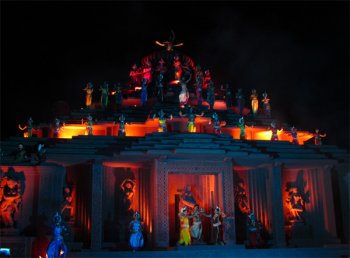 Panchadeva stuti 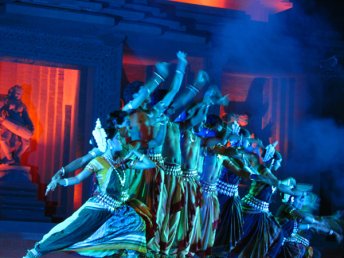 Guru Gangadhar vandana Inaugurated by Swami Shankarananda Giri, the 5-day Konark Dance and Music Festival conducted by the Guru Gangadhar Pradhan Foundation got off to a beautiful start at the open air auditorium of Konark Natya Mandap with the backdrop designed to mimic the pyramid of the famous Konark Sun Temple. Beautiful sculptures of dancers and musicians are spaced out in the niches at the back of the stage and flanking the sides. It is the custom to start every evening of the festival with Panchadeva stuti with garland brought from Balukeshwar temple. The Panchadeva stuti starting with the blowing of the conch from the top of the pyramid saw the Foundation children appearing with lit diyas on the tiers of the superstructure and on stage and the grand sight set to dramatic lighting never fails to elicit admiring gasps from the audience. This dance fest is the brainchild of late Guru Gangadhar Pradhan, former president of the Odisha Sangeet Natak Akademi, and the founder of the Orissa Dance Academy in Bhubaneswar in 1975. He is often referred to as the father of festivals in Odisha. Now in its 27th year, one and half years after Guruji’s demise, the tradition continues through the efforts of his son Shibasish Pradhan, devoted family members and disciples. The Guru Gangadhar vandana was presented in tribute, evoking nostalgia and emotional reactions from those who knew him well. (At the end of the evening’s program, we spotted Guruji’s sister weeping inconsolably.) 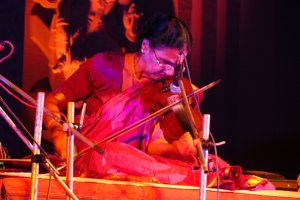 Dr. N Rajam
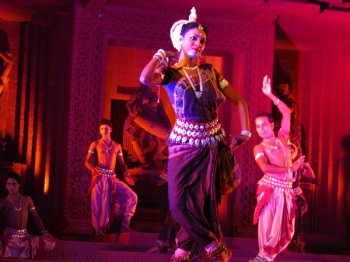 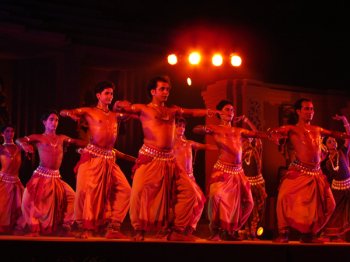
Konark Lasya Leela
The dancers of Guru Gangadhar Pradhan Foundation led by Lingaraj Swain
presented the Konark Lasya Leela. With the passing of the
night, the moonlight calls to the dance and music sculptures of the
Konark Sun Temple and they begin dancing to the intoxicating music in
the moonlight. As sculptures frozen in stone, the dancers remained quite
motionless, with the lead role played by Ellora Patnaik clad in an all
white costume. This was choreographed by Guru Gangadhar Pradhan 25
years back and the 8 male and 8 female dancers performed this favorite
composition of their guru with much sincerity. The setting was
also perfect for this item. The music and accompanying orchestra
enhanced the dance performance. Because of the size of the stage,
it never looked crowded even with 16 dancers on it through out.
The item ended with “Adityaya namo namah, suryaya namo namah.”The concluding performance by the young Gotipua dancers of Konark Natya Mandap trained by Guru Birabar Sahoo was hugely enjoyed by the audience especially the children who broke out into delighted applause every time the dancers formed complicated human pyramids or twisted their bodies into weird shapes. The first lady from Andhra to sing Hindustani classical, Sumitra Guha started the second day of the fest. She was accompanied by two of her disciples, and Aniruddha Mukherjee on tabla, Gaurav Chatterjee on harmonium. Being the Sivaratri night, she sang songs on Shiva – “Mahadev Deva Maheshwara” and “Sada Shiva Shambu” – as well as on Vishnu, “Aaj Ghanshyam aaye” and “Aaye man moh liya.” 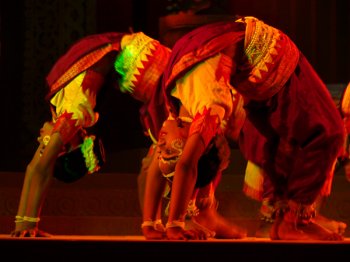 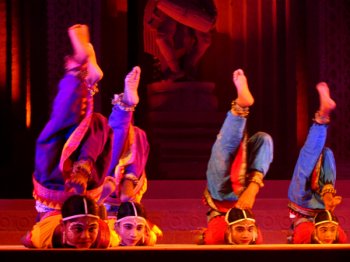
Gotipua dancers of Konark Natya Mandap
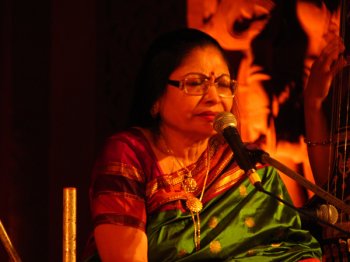 Sumitra Guha 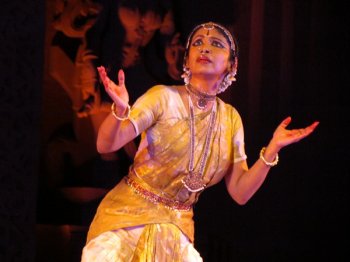 Alarmel Valli This was followed by a sparkling Bharatanatyam recital by the vivacious Alarmel Valli in her first performance at Konark. By announcing that she had learnt Odissi for 10 years under Guru Kelucharan Mohapatra and Ramani Rajan Jena that helped enrich her dance experience, she won over the hearts of the Oriya people present. “Rati sukha sare” composed by Rajkumar Barathi in celebration of love and shringara rasa with verses from King Bhoja’s Shringaara Prakashanam and Kalidasa’s Ritu Samharam included a brief depiction of the navarasas. The next item also composed by Rajkumar Barathi was about the intimate and infinite myriad dimensions of Krishna, the approachable person on one hand, the Supreme Being on the other. Verses from Bhagavad Gita where Krishna reveals himself to Arjuna in cosmic form, tender depiction of child Krishna, his effortless dance on the head of the 5 headed snake Kaliya in a verse from Yadavabyudayam concluding with a raasa kreeda to verse from Narayaneeyam were woven together with Madurashtakam. One did wonder if the petite Valli would look lost on the big stage that is more suited to group performances, but she covered the space well, her off white with brocade costume standing out against the reddish background. The quality of the recorded music was excellent. A youngster (maybe about 10 to 12 years old) sitting next to us so enjoyed the performance… he was playing an imaginary mridangam through the recital! Valli’s performance felt too short and had the audience wanting for more. On receiving the citation and Rs. 25,000 purse of the 15th Sanjukta Birla Prativa Samman (courtesy Studio Sound Master) from the Raja of Puri and Swami Shankarananda Giri, Valli thanked the organizers for their superb hospitality and expressed her wish to donate the amount she was awarded to a worthy cause to promote art wherein young Oriyan artistes would be benefited. Indeed an admirable gesture. The evening concluded with a charming performance by Ranranga Dance Academy from Sri Lanka. They presented Kandyan dance and folk dances like harvest dance and dance of creation.  Ranranga Dance Academy 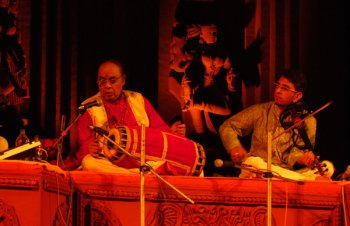 Dr. Yella Venkateswara Rao & Thyagaraju Dr. Yella Venkateswara Rao hailing from a traditional music family in Andhra is featured in the Guinness Book of Records for playing mridangam for 36 hours at a stretch. With 60 years of experience in the field, his was a distinguished start to the third evening of the fest. Starting with “Vatapi Ganapathim” of Dikshitar, he also played his own compositions, his fingers flying over the mridangam in the tani avardhanam that had the audience applauding in rapture. He was accompanied by Pramod on flute, Nageswara Rao on keyboard, his grandson Abhishek on rhythm pad and Thyagaraju on violin. The modern art shape of the violin caught one’s attention and after the concert, the artiste graciously showed me the precious violin, a model SV255 available in the US that weighs only 500gm and costs Rs.1.5 lakhs, a gift from his father and guru Peri Sriramamurty. This was followed by a Kathak recital by Pt. Rajendra Gangani, disciple of Pt Kundanlal Gangani of the Jaipur Gharana, and his troupe. The first half of the program featured Gangani performing typical Kathak bols, Gajagamini ki chaal, Ganesh paran, Govardhan Leela, Gaj paran, damaru of Shiva and ghungroo etc. Clad in a brownish costume, he blended into the background and looked like one of the statues in the niches come to life! This is the second time he is performing at the Konark fest and he announced in all humility that “this is not a performance but a tribute to Guruji.” He dedicated “Guru bin aisi kaun kare,” a bhajan by Surdas, as special tribute to Guru Gangadhar Pradhan. The second half of the program was an elegant group item by his female disciples wearing beautiful turquoise and dark blue costumes, with Gangani on tabla. 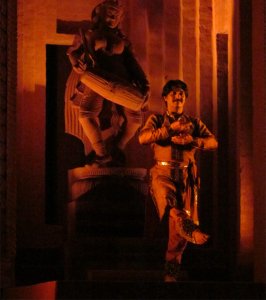 Pt. Rajendra Gangani 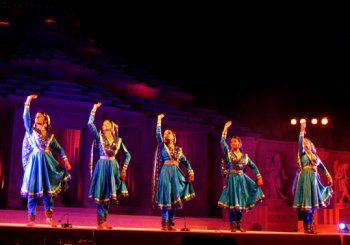 Disciples of Pt. Rajendra Gangani 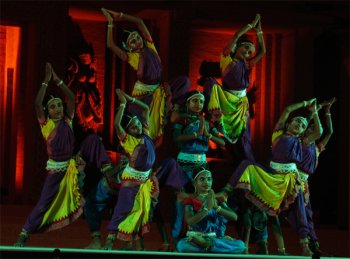 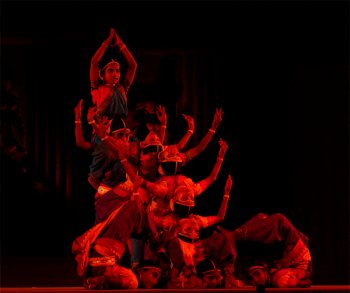
Gotipua dancers of Konark Natya Mandap
Since the shank dhwani group that was to have performed ran into some travel problems, the Gotipua wing of Konark Natya Mandap gave a repeat performance of bandh nritya cheered lustily by the audience. Some of the foreigners, like a couple from Hawaii, had timed their visit to India to coincide with this festival. Day 4 started with an erudite Odissi vocal performance by Dr. Damodar Hota, a Hindustani classical musician trained in the Gwalior Gharana. He presented Jagannath vandana in a rare raga, an Odissi prabandh of Oriya poet Upendra Bhanja in triputa tala and a Tribanga set to ektali that had the audience clapping spontaneously in rhythm. 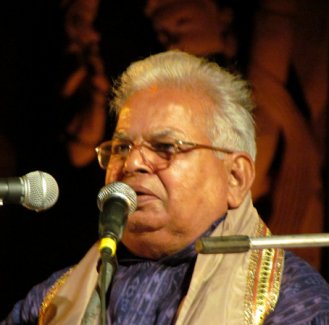 Dr. Damodar Hota  Kalyana Srinivasam This was followed by a Kuchipudi dance drama ‘Kalyana Srinivasam’ by Sobha Naidu and her 24 member troupe from Hyderabad. Starting with a traditional vani parakku, the story is about how Lord Srinivasa, as a hunter, enters the garden of Padmavati where she is playing with her sakhis. The hunter wants to know who the pretty girl is. He assumes the disguise of a fortune teller, reads Padmavati’s palm and predicts the happy events to follow. Some very young dancers enacted a basic celebration dance followed by a wedding scene where Brahma acts as priest. One of the dancers brought a cell phone to the orchestra and then left in view of the audience. There were time lapses between scenes and it was more theatrics than dancing, not even a swaying walk when exiting the stage. The coy glances exchanged by Srinivasa and Padmavati in the garden scene were rather cinematic. Sarvani Yadavalli in the part of the soothsayer was good. Srinivasa with blue hued face, the crowns and costumes, and lip synching the lyrics was reminiscent of typical Kuchipudi dance dramas. The finale was a foot tapping Bhangra dance by Mauj Punjabi Di from Mumbai. The infectious energy and the joie de vivre of the presentation had the audience whistling and clapping in enjoyment. 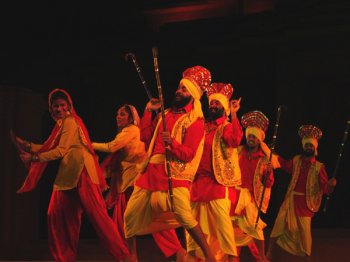 Mauj Punjabi Di 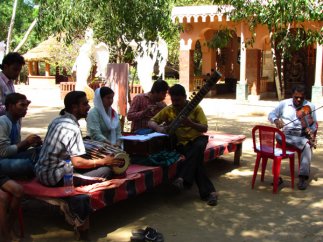 Rehearsing at Konark Natya Mandap for evening show. Devraj Patnaik on percussion We visited the Konark Natya Mandap in the morning and had the pleasure of climbing to the top of the backdrop to the amla, from where the kids perform Panchadeva Stuti! When we watched the rehearsal seated under the casuarina trees, Devraj Patnaik and his sister Ellora Patnaik did promise that though there are so many versions of the ten incarnations, this one was different. Ellora spoke with feeling about her guru Gangadhar Pradhan from whom she learnt Odissi from a very young age, recalling his extraordinary powers of teaching; how at the age of 12 she carried bricks and helped in building the mandap! Having seen and helped in the development of this stage from an ordinary platform to this beautiful work of art, she is enthusiastic about helping develop it further. Like Ellora and Devraj Patnaik, people are still upset over the untimely demise of Guru Gangadhar Pradhan due to unfortunate cirucumstances, and cannot get over the loss to the Odissi world of a great mardal player, graceful dancer and an inspired teacher who in his later years became more absorbed in event managing leading to great stress on his health. The final evening of the festival was its crowning glory with three stellar performances. It was a sold out show with people standing all along the sides as well as seated in the aisles, a happy sight to behold! Chitralekha Odissi Dance Creations presented 2 brilliant items with music composition, rhythm and choreography by Guru Devraj Patnaik, who has trained in Odissi under gurus Pankaj Charan Das, Kelucharan Mohapatra, Gangadhar Pradhan and Sanjukta Panigrahi. He has also trained in pakhawaj and tabla under gurus Banamali Moharana and Umesh Chandra Kar. This helps him bring fresh perspective in his dance choreography and music composition as was evident in the evening’s performance. Originally a solo, ‘Sringar Nritya’ is basically a Pallavi in rag Bahar set to ektali featuring 11 female dancers - students of Guru Gangadhar Pradhan Foundation with Ellora Patnaik, Sangeeta Sarkar and Meenakshi Natarajan from Canada. The uniform costumes were aesthetic, group formations were interesting and the movements elegantly replicated the sculptures of female dancers and musicians of the Sun Temple. (Incidentally, with every visit to the temple, we see more sculpture panels being eroded and replaced with plain stone. At this rate of deterioration, we will soon see the dancing sculpture of Konark only in the Odissi dance recitals.) ‘Dashavatar’ from the Gita Govinda was performed by 8 male dancers. It was an impressive world premiere and with its beautiful music and innovative portrayal, lived up to its promise of being quite different from other presentations of this theme. 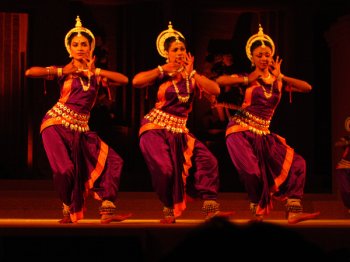 Sringar Nritya  Dashavatar 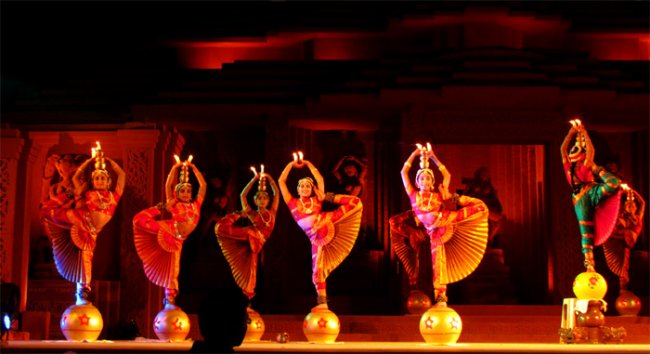 Deepa Tarangini This was followed by a spectacular performance of ‘Deepa Tarangini’ by students of Sri Rama Nataka Niketan from Hyderabad trained by Guru Manjula Ramaswamy under the guidance of her illustrious father Guru VS Ramamurthy. After “Shankara Sri Giri” was performed by 2 dancers, about a dozen young female dancers entered the stage, balanced on inverted pots with small three tiered brass pots on their head and lit candles in their hands. The pedestal of the dancer in the centre was even higher. They mesmerized the audience with their perfect balance, impeccable timing and coordination. With their flexible bodies, the dancers struck beautiful poses, some rather acrobatic and the audience went into raptures. They even did a few dance movements while balancing on the pots. What was the inspiration for choreographing this piece? Having read about this dance on the pot performed by E Krishna Iyer (lawyer, freedom fighter, artiste and activist who was responsible for popularizing the dying art of Bharatanatyam), they were inspired to choreograph this group production, said Manjula Ramaswamy. Deepa Tarangini presented by 50 students has won a place in the Limca Book of Records, Asia Book of Records, India Book of Records, Unique World Records, World Amazing Records and World Records India. The star of the evening was undoubtedly tabla maestro Ustad Zakir Hussain, who received the 2nd Guru Gangadhar Pradhan Lifetime Achievement Award comprising of a cash prize of Rs. 1 lakh and a citation, from flute maestro Pt Hariprasad Chaurasia. “Don’t call me Ustad. We are small in front of stalwarts like Pt Hariprasad Chaurasia. This hallowed stage built by Guru Gangadhar Pradhan is like a temple and I am fortunate to perform here,” said Zakir Hussain endearing himself to the audience. There were no star tantrums over sound adjustments (he called it Chinese classical!) and the recital commenced with minimum fuss. Zakir Hussain is undoubtedly one of the world’s greatest tabla maestros. He was accompanied by Sabir Khan on sarangi. The ninth generation to take up sarangi after his father the iconic Ustad Sultan Khan, Sabir Khan’s technique of playing is a rare combination of sur and laya (note and rhythm). Zakir Hussain’s daughter and wife, Kathak dancer Antonia Minnecola, were present and he made that a reason to present some scintillating Kathak bols. In an engaging manner, Zakir Hussain took the audience through the demo of various bols like rhythm of the train, deer in a forest startled by a hunter, rain accompanied by dark clouds and lightning, the exploding of a bomb to name a few. The combination of tabla and sarangi was nothing short of magic as the two artistes enthralled with their formidable expertise and mastery over their instruments, their joy of performing evident in their smiling faces. 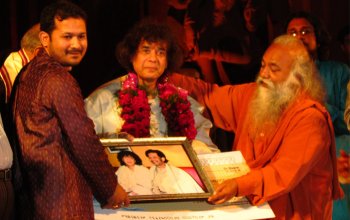 Shibasish Pradhan, Zakir Hussain, Swami Shankarananda Giri 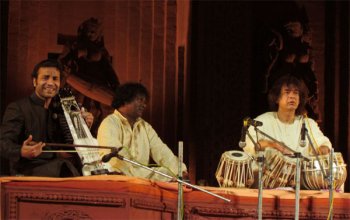 Sabir Khan, Zakir Hussain Big posters of Guruji with prominent personalities (including one with Zakir Hussain) and in dance poses, lights and flower festoons decorated the festival space aesthetically. Apart from many well wishers, Subash Sahoo (set designer), Nalini Nihar Nayak (stage light designer), Tarakant Panda (sound engineer) and Aparna Banerjee of Antara Arts (Bangalore) slogged to make the fest a success. This year, guest light designer Shivarajah Natarajan from Sutra, Malaysia, lent his expertise in executing the lights for the fest. Since announcements are in Oriya and English, some more editing of text is necessary. At the end of it all, no one would have guessed at the many difficulties faced in conducting a festival of this magnitude, for everything went off smoothly and serenely, a just tribute to the memory of Guru Gangadhar Pradhan. More photos Lalitha Venkat is the content editor of www.narthaki.com |